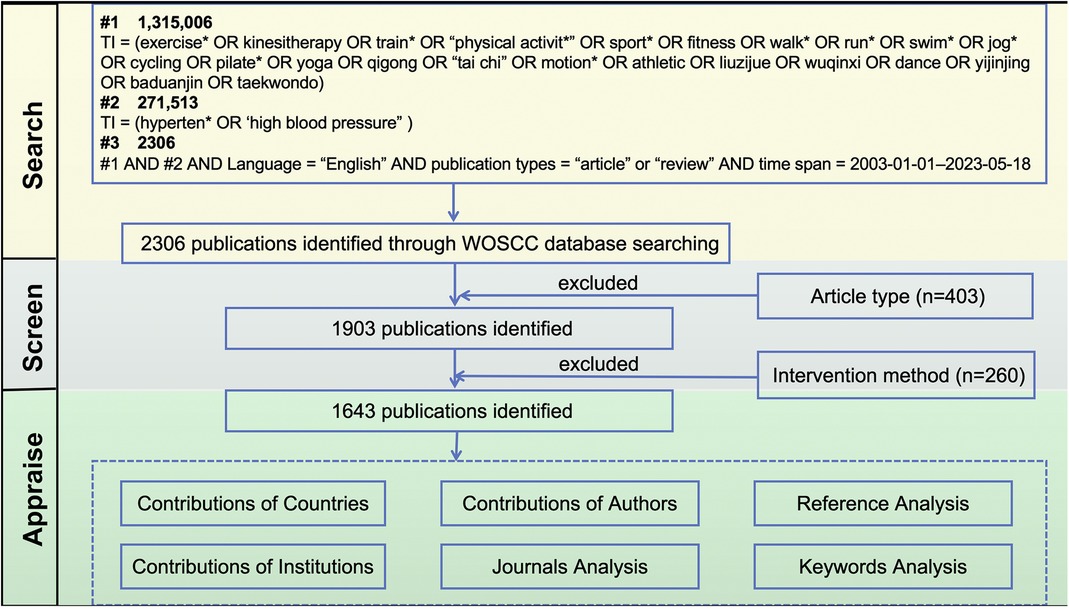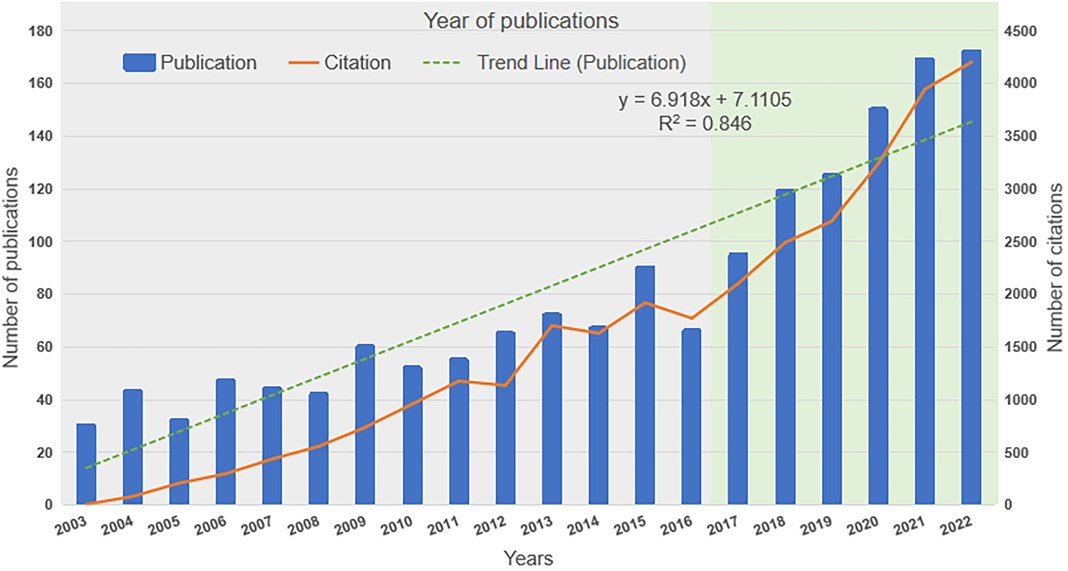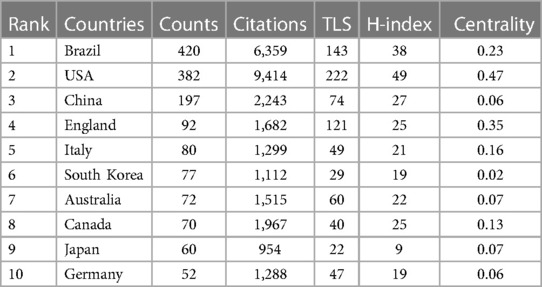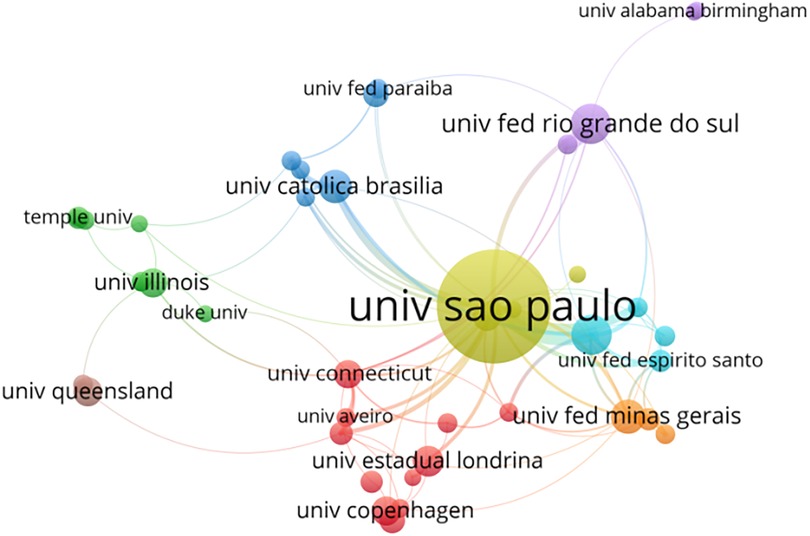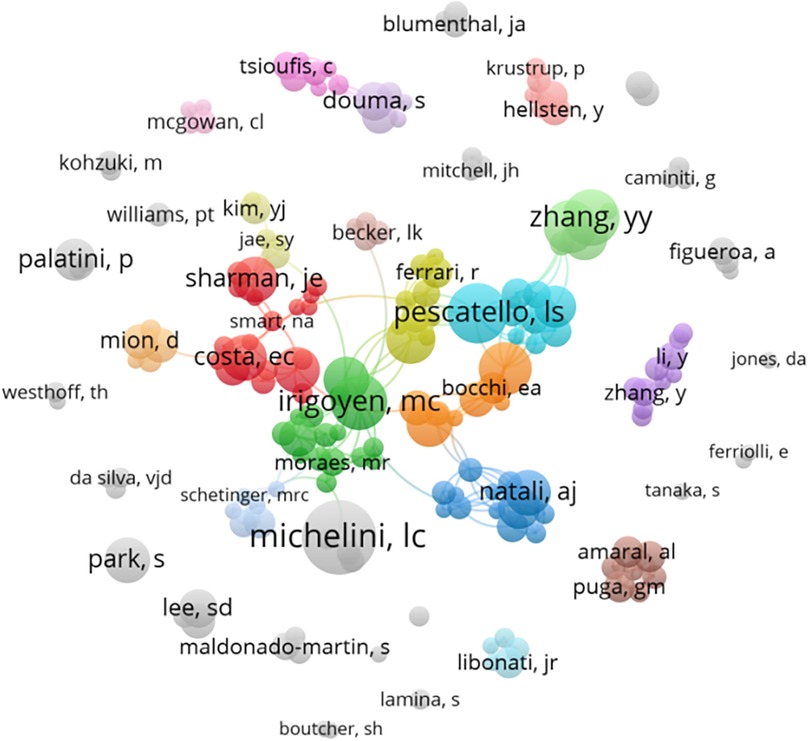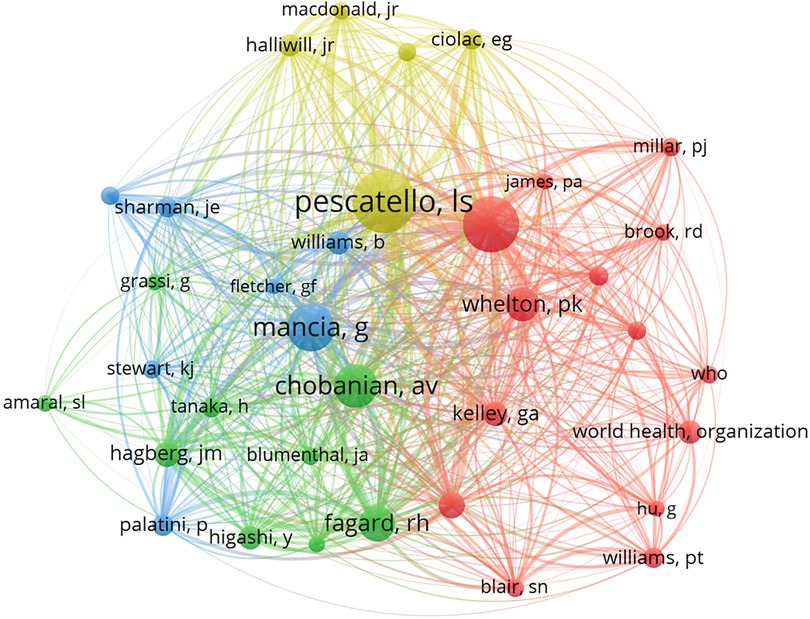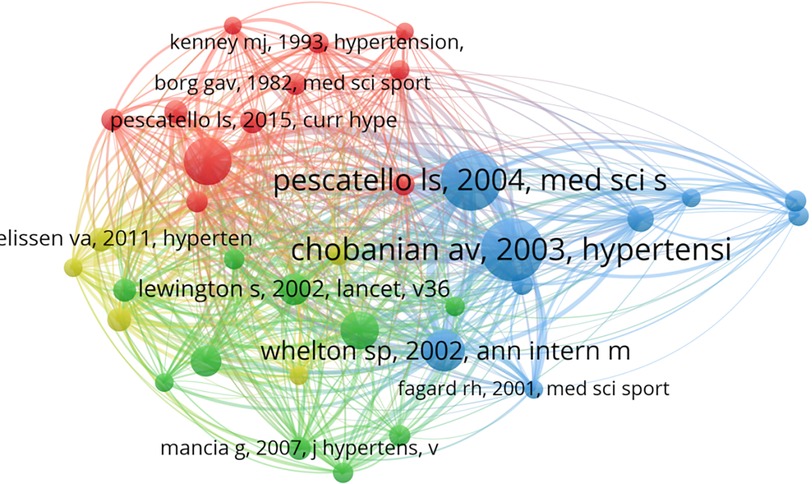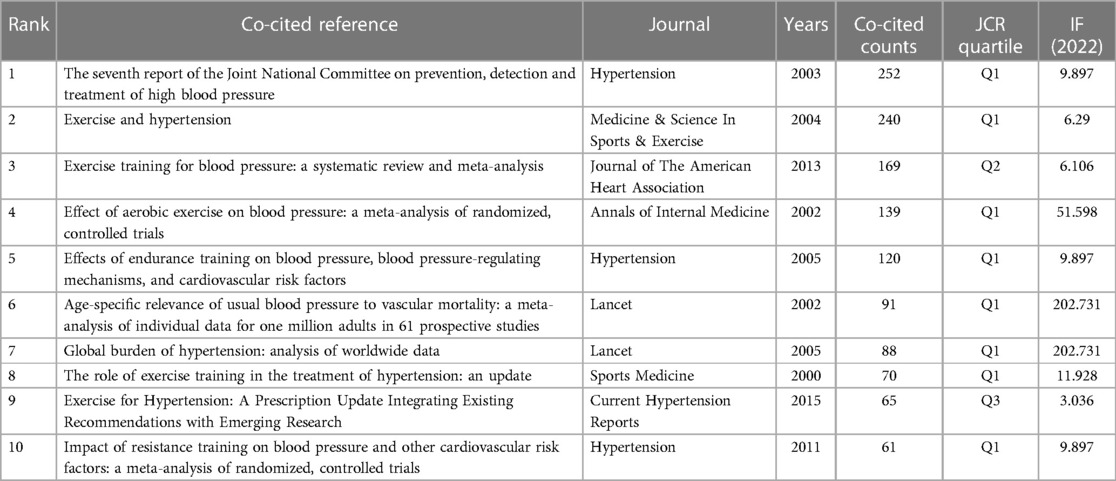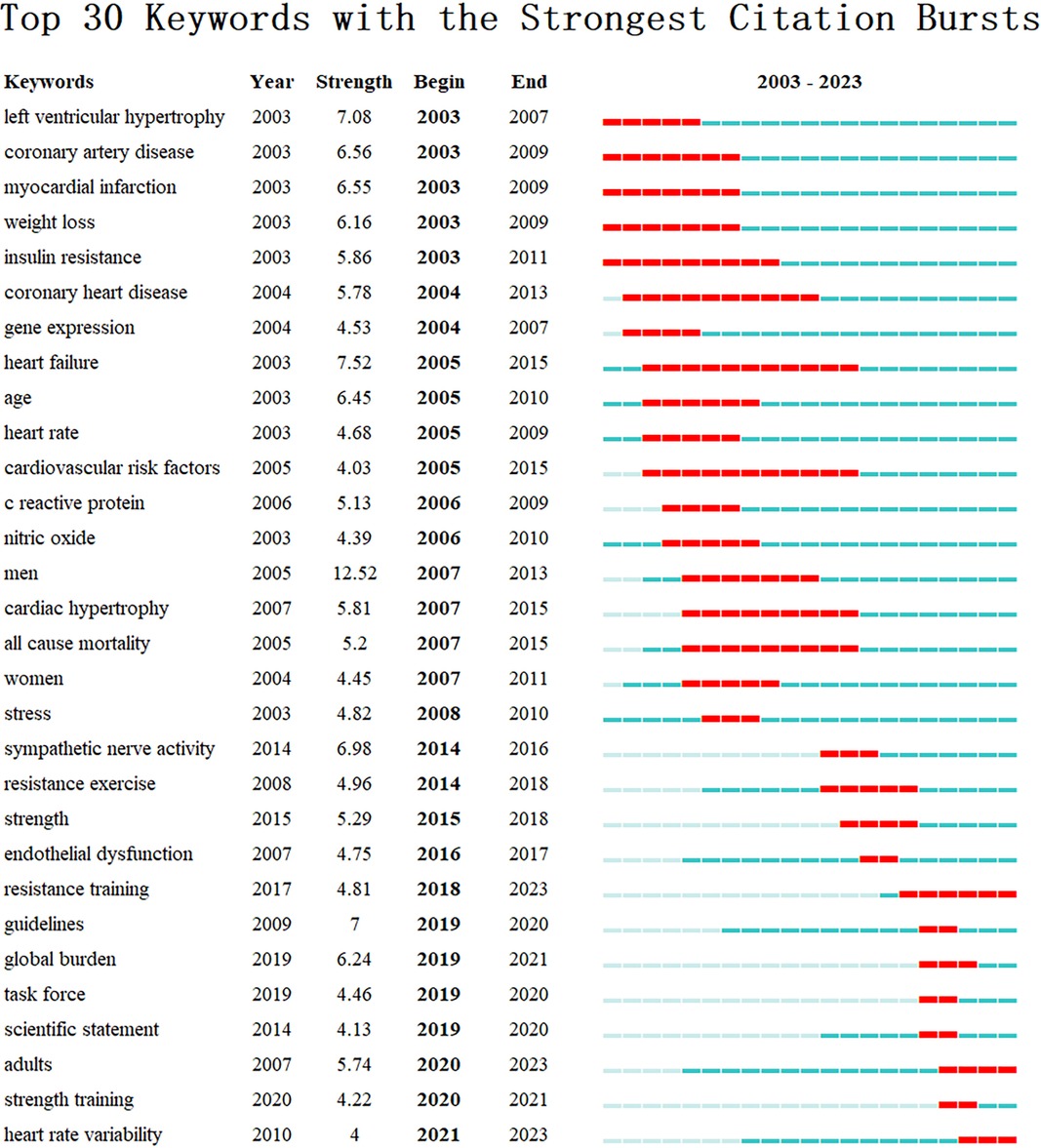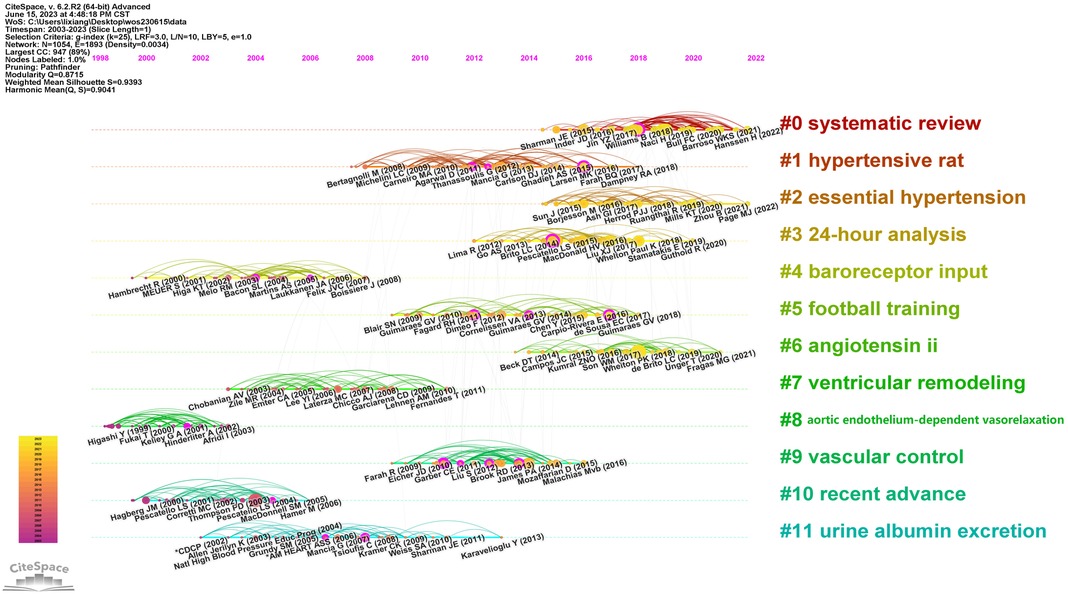- 1Rehabilitation Medicine Center and Institute of Rehabilitation Medicine, West China Hospital, Sichuan University, Chengdu, China
- 2Key Laboratory of Rehabilitation Medicine in Sichuan Province, Sichuan University, Chengdu, China
- 3Department of Nursing, Zhejiang Zhoushan Tourism and Health College, Zhoushan, China
- 4Department of Nursing, Lishui Central Hospital and Fifth Affiliated Hospital of Wenzhou Medical College, Lishui, China
- 5Department of Nursing, Hangzhou Normal University, Hangzhou, China
- 6Department of Nursing, the First Affiliated Hospital of Zhejiang Chinese Medical University (Zhejiang Provincial Hospital of Traditional Chinese Medicine), Hangzhou, China
Objective: To investigate development trends and research hotspots of exercise for hypertension research and provide researchers with fresh perspectives for further studies.
Materials and methods: Articles and reviews regarding exercise and hypertension spanning May 1st 2003 to May 18th 2023 were retrieved from the Web of Science Core Collection (WOSCC) database. VOSviewer and Citespace were mainly used to perform and visualize co-authorship, co-citation, and co-occurrence analysis of countries, institutions, authors, references and keywords in this field.
Results: A total of 1,643 peer-reviewed papers were identified, displaying a consistent increasing trend over time. The most prolific country and institution were Brazil and University of Sao Paulo, respectively. And we identified the most productive author was lrigoyen, Maria Claudia C, while Pescatello Linda S was the most co-cited author. Journal of hypertension was the most prominent journal, and Hypertension was the journal which was the most co-cited. And this field can be divided into 3 research themes: exercise interventions for hypertension, age-specific relevance of exercise for hypertension, and the global burden of hypertension and the role of exercise. According to the result of keywords analysis, epidemiological information, types of exercise, target population, mechanism, and study design are significant research areas. “Resistance training”, “adults”, and “heart rate variability” were identified as the major future research foci.
Conclusions: The findings offer a scientific insight into exercise for hypertension research, presenting researchers with valuable information to understand the current research status, hotspots, and emerging trends for future investigation.
Introduction
Hypertension, commonly known as high blood pressure, is characterized as a persistent elevation in blood pressure with an unclear etiology, thereby amplifying the risk for cerebral, cardiac, and renal events (1). The precise medical definition of hypertension varies among clinicians due to differential guideline recommendations. Some suggest that hypertension is defined by consistent readings exceeding 130/80 mmHg, whereas others advocate for a threshold of 140/90 mmHg (2). In the year 2010, hypertension was reported in approximately 31.1% of the global adult population. Projections predicted a rise of 60% by 2025, resulting in a prevalence of 29.2%, or around 1.56 billion individuals (3, 4). By 2010, hypertension had emerged as the predominant single risk factor contributing to the global disease burden, accountable for 9.4 million deaths and 7.0% of global disability-adjusted life years, with impacts across all socio-economic strata (5, 6). The economic implications of hypertension are also considerable. In 2003, the cumulative direct and indirect expenses associated with the management of hypertension in the US were estimated to be USD 50.3 billion (7).
The challenge with hypertension lies in its often-asymptomatic nature, making it difficult for individuals to realize their condition. If left uncontrolled over extended periods, hypertension can precipitate severe medical conditions, such as heart failure, myocardial infarction, stroke, vision complications, and kidney disease (1). Therefore, patient monitoring is a crucial aspect of hypertension management. It's typically controlled by medication and lifestyle changes, with exercise playing a crucial role. Numerous therapeutic exercise regimens have been implemented as interventions in hypertension management (8). In recent years, a multitude of studies have demonstrated that aerobic and resistance exercise, coupled with flexibility and balance exercises, can augment the quality of life for patients with hypertension (9, 10). These improvements manifest in various ways such as enhancing cardiovascular system function, optimizing blood pressure control, and reducing the risk of apoplexy (11, 12).
Bibliometric analysis, a robust quantitative research methodology, offers an objective framework to trace the intellectual evolution and structural composition of a specific research domain (13). It has been widely utilized to probe developmental trends and hotspots within various areas of publication (14–16). To our understanding, despite the steady increase in publications relating to exercise in the hypertension research field, no bibliometric analysis has yet been conducted. Findings derived from such bibliometric studies can enable investigators to pinpoint current research concerns, thereby guiding future research directions (17). Owing to its considerable advantages, the application of bibliometric methods holds significant value in the domain of exercise for hypertension research.
In this study, our objective is to conduct a thorough bibliometric analysis of research concerning exercise for hypertension. The intention is to offer a comprehensive assessment of the evolution within this field. By meticulously examining past achievements, evaluating the present state, and projecting potential future directions, we aspire to illuminate the landscape of exercise for hypertension research.
Materials and methods
Data acquisition
The Web of Science Core Collection (WOSCC) database was searched extensively for publications relating to exercise for hypertension on 19 May 2023, which is frequently used and accepted for scientific or bibliometric studies. A peer-reviewed and supervised search term development process was conducted under the guidance of an expert with ten years of information retrieval experience. The data search strategy was “TI = (exercise* OR kinesitherapy OR train* OR “physical activit*” OR sport* OR fitness OR walk* OR run* OR swim* OR jog* OR cycling OR pilate* OR yoga OR qigong OR “tai chi” OR motion* OR athletic OR liuzijue OR wuqinxi OR dance OR yijinjing OR baduanjin OR taekwondo) AND TI = (hyperten* OR “high blood pressure”) AND Language = “English”. In this study, the publication types were restricted to “article” or “review”, time span = 2003.01.01–2023.05.18 (Figure 1).
Data analysis and visualization
The data, which incorporates fully recorded and cited references, was downloaded from WOSCC. In addition to the Online Analysis Platform of Literature Metrology (https://bibliometric.com/), VOSviewer 1.6.17, and CiteSpace 6.1.R3, this information was also imported into several analysis tools. The key metrics adopted in bibliometric studies encompass co-authorship, co-citation, and co-occurrence analysis. Specifically, co-authorship analysis aims to investigate the relationships among authors, nations, or institutions, predicated on the quantity of jointly produced papers. Co-occurrence analysis employs a quantitative methodology to explore the relationship between different elements, based on their concurrent appearances. Co-citation analysis reveals the relational strength of cited elements by considering the number of elements that cite them.
The Online Analysis Platform of Literature Metrology was employed for conducting co-authorship and publication analyses across various countries/regions. VOSviewer serves as a software tool for the creation and visualization of bibliometric networks, which may be formulated leveraging citations, common citations, or co-authorship collaborations (18). In the map instantiated by VOSviewer, each node symbolizes an element. In the context of this study, VOSviewer facilitated the analysis of clustering patterns among countries, institutions, authors, and journals, taking into account the number of publications, citations, and the linkage potency of each constituent. A wide link width between nodes signifies a robust degree of cooperation, and larger nodes denote a higher number of reflections. Concurrently, CiteSpace served as an invaluable tool for bibliometric analysis (19, 20). Utilizing CiteSpace, we assessed keyword/reference clustering and timelines, as well as the centrality of countries, institutions, authors, and keywords. CiteSpace parameters were set as follows: (1) Time slice from 2003 to 2023, with each slice representing one year; (2) Single node type selection at a time; (3) Selection criteria were based on the g-index, with k = 15; (4) Pruning was performed via the pathfinder method. Moreover, Microsoft Excel 2019 was deployed to illustrate the global output and developmental trend of relevant papers. Impact factor (IF) and category quartile data were derived from the Journal Citation Reports (JCR) 2022 (21). The H-index is a composite index that serves as a significant metric for evaluating the quantity and quality of academic output produced by a scientific researcher, country, journal, or institution.
Research ethics
The data sources utilized in our study were derived from publicly accessible databases. As such, obtaining approval from an ethics committee was deemed unnecessary.
Results
General information
Analysis of publications
A total of 1,643 publications focused on exercise for hypertension research were identified between Jan 1st, 2003 and May 18th, 2023, including 1,485 articles and 158 reviews. The average annual output was 83. As presented in Figure 2, the field of exercise for hypertension research exhibited a fluctuating publication output from 2003 to 2016, with an overall upward trend since 2017. The sustained increase in publications after 2017 likely reflects the growing recognition of exercise as a non-pharmacological intervention for hypertension prevention and management. The rising volume of publications on exercise for hypertension indicates that more studies are being conducted in this field, leading to the generation of new knowledge. The increasing interest in this topic might also indicate a recognition of the importance of non-pharmacological interventions for hypertension. Moreover, the 1,643 publications in this research field were cited a total of 32,491 times from 2003 to 2023. The number of citations increased from 5 in 2003 to 4,203 in 2022. The increase in citation rates over time indicates that the findings and insights produced by these studies are significant and relevant to the scientific community.
Analysis of countries/regions
Publications were published in 80 different countries/regions (Figure 3). Table 1 lists the top 10 most productive countries/regions, with Brazil (n = 420) leading, followed by the USA (n = 382), and China (n = 197). The USA had the highest citation count (9,414 times) and H-index = 49. Figure 3A shows a concentration of publications in North America, South America, Europe, and East Asia. Notably, China exhibited a substantial increase in publication output in 2021 (Figure 3B); this may be due to increased investment in research and development, an aging population, and high rates of hypertension prevalence (22–24). The cooperation network between countries and regions is depicted in Figures 3C,D, indicating that the USA collaborates with various countries, particularly Brazil and China. Total link strength (TLS) measures global co-authorship and is represented by the width of the lines connecting nodes. The visual co-authorship map reveals that the top three countries in terms of TLS are the USA, Brazil, and England. Beyond the USA, collaboration among other nations is limited. This underscores the need for fostering international partnerships to further advance exercise for hypertension research. Collaboration can pool resources, expertise, and knowledge from various regions to conduct more comprehensive and impactful studies.
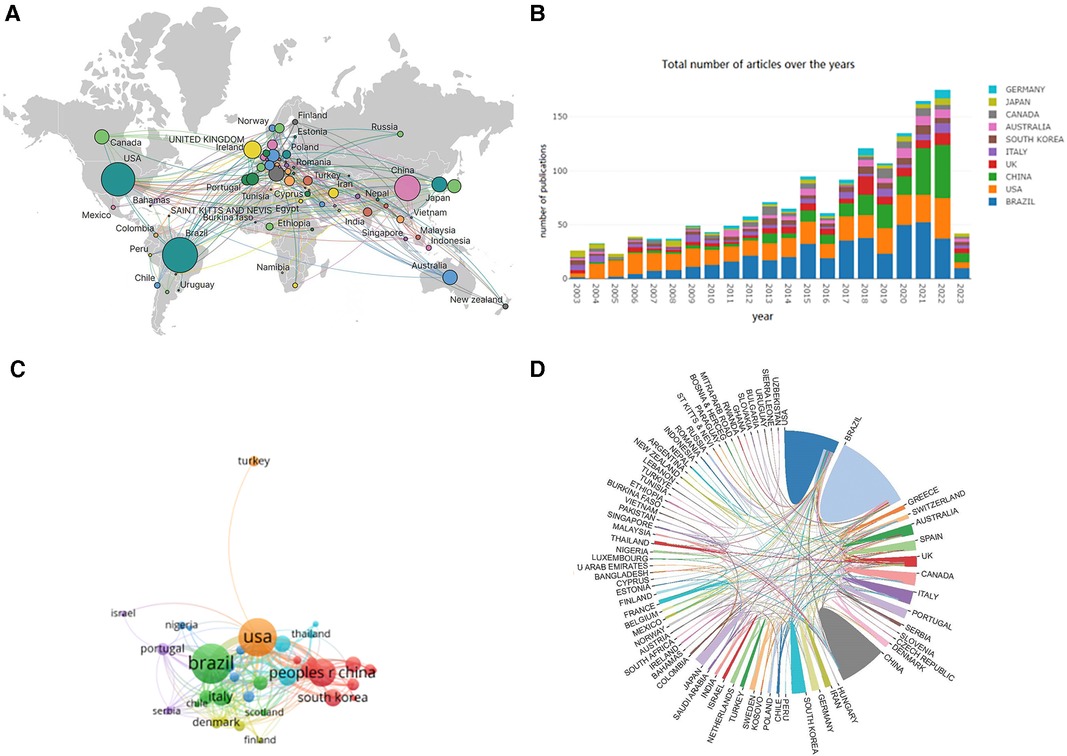
Figure 3. Visual map of countries/region. (A) Geographic distribution map based on the total publications of different countries/regions. (B) Number of annual publications and growth trends of the top 10 countries/regions. (C) Collaboration network analysis of the countries/regions. (D) The international network cooperation between the countries/regions.
Analysis of institutions
Publications originated from 2197 different institutions (Figure 4). Table 2 lists the top 10 most productive institutions. The University of Sao Paulo published the most papers (n = 139), followed by Federal University of Sao Paulo (n = 32) and Universidade Federal do Rio Grande do Sul (n = 32).
Analysis of journals
Over the past 20 years, 280 academic journals published articles related to exercise for hypertension. The top 10 journals published 23.25% (n = 382) of these papers, as shown in Table 3. The average IF of the top 5 journals is 5.914. Hypertension (n = 48, IF = 9.897), a journal from the USA, had the highest IF among these journals. It focuses on basic science, clinical treatment, and prevention of hypertension and related cardiovascular, metabolic and renal diseases. The articles published in Hypertension are expected to remain significant for years to come. In terms of publications volume, the top three journals were Journal of hypertension (IF = 4.776), Hypertension (IF = 9.897), and Hypertension research (IF = 5.528). The Journal of Hypertension, based in the USA, focuses on research related to the basic science, clinical treatment, and prevention of hypertension, as well as associated cardiovascular, metabolic, and renal diseases. Given the quality and scope of its published papers, they are expected to remain significant for years to come.
Analysis of authors
As many as 8,145 authors contributed to the research on exercise for hypertension. Table 4 presents the top 10 authors in exercise for hypertension research, with Maria Claudia C. Irigoyen ranking first (n = 18), followed by Linda S. Pescatello (n = 17), Li-jun Shi (n = 15). The cooperation map (Figure 5) indicates that the scale of collaboration among authors is relatively light, suggesting a need for increased overall connections between researchers in this field.
Research hotspots
Analysis of co-cited journals
The top 10 most-cited journals are displayed in Table 5. A journal's influence in its respective field is determined by the frequency of co-citations, serving as a measure of its significance. Notably, nine journals in Table 5 have been cited over 1,000 times. The three most frequently co-cited publications were Hypertension (IF = 9.897), Circulation (IF = 39.918), and Annals of Internal Medicine (IF = 51.598).
Analysis of co-cited authors
The network map of co-cited authors is shown in Figure 6. Linda S. Pescatello ranked first with 482 citations, followed by Cornelissen Véronique A, Mancia Giuseppe, and Chobanian Aram V with 411, 325, and 297 citations, respectively (Table 6). The top 10 co-cited authors collectively exceeded 2,000 citations, highlighting their prominence and influence in the domain of exercise for hypertension research.
Analysis of co-cited references
Reference co-citation analysis determines highly co-cited references that are frequently cited together by other articles, making it a common approach for exploring research foci in a given academic field. The network map of co-cited references is displayed in Figure 7, and Table 7 lists the top ten articles according to number of citations. We concluded that these ten articles concentrate on 3 research themes: (1) exercise interventions for hypertension prevention and treatment, (2) age-specific relevance of exercise for hypertension, (3) the global burden of hypertension and the role of exercise.
Analysis of keywords co-occurrence
Keywords summarize the core material of a paper in great detail. Table 8 reports the top 20 keywords, while Figures 8A,B illustrate the co-occurrence and cluster analysis of these keywords, respectively. Within the exercise for hypertension research, significant research areas encompass epidemiological information (e.g., risk, mortality, prevalence), types of exercise (e.g., aerobic exercise, resistance exercise), target population (e.g., adults, men), mechanism (e.g., adrenergic blockade, oxidative stress), and study design (e.g., meta-analysis). To display temporal trends, a timeline plot was constructed (Figure 8C). In the field of exercise for hypertension, a total of seven clusters have been identified, with “#2 hypertension-induced diastolic heart failure,” “#3 isometric handgrip training,” “#5 hypertensive response,” and “#7 atrial natriuretic peptide” emerging as recent research hotspots.
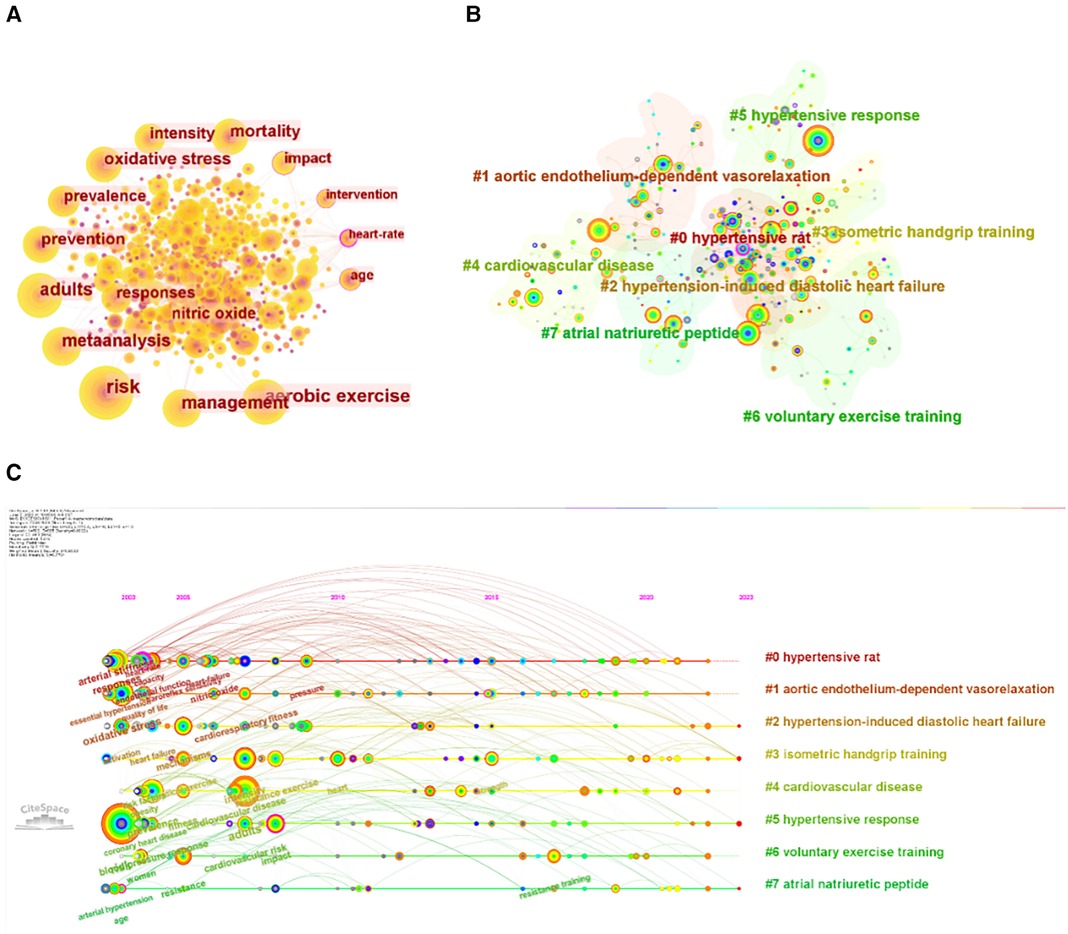
Figure 8. Analysis of keywords. (A) Keywords co-occurrence. (B) Keyword clustering. (C) Timeline of keywords.
Global trends of exercise for hypertension research
Analysis of keywords with the strongest citation bursts
Since 2003, a total of 30 keywords have experienced significant bursts. The results of burst detection are illustrated in Figure 9, showing that keywords such as “resistance training”, “adults”, “heart rate variability” gained prominence in recent years. This indicates that research concerning these topics is currently garnering attention and signifies potential developmental trends in the field of exercise for hypertension research.
Analysis of co-cited references
The timeline view of co-cited references serves as a visual diagram reflecting the temporal characteristics of research hotspots in this field. Among the 12 clusters depicted in Figure 10, the #8 cluster, focusing on aortic endothelium-dependent vasorelaxation, emerged as the earliest research hotspot. Currently, the most prevalent research hotspots are #0 systematic review and #2 essential hypertension.
Discussion
General information
The research on exercise for hypertension has been extensively studied over the last two decades. The subject has been researched in 80 countries, with eight developed and only two developing countries among the top 10 countries studied. Despite ranking second in published papers, the USA has the highest centrality score, indicating its leadership in this research area. This can be attributed to the country's high prevalence of hypertension and substantial investment in exercise treatment for hypertension. Brazil ranks first in the number of articles published on this topic. This may be associated with the high incidence of hypertension in the country and the low cost of exercise treatment (25). China follows closely in third place, which may also be credited to the high incidence of hypertension and the popularity of traditional Chinese practices such as Baduan Jin and Tai Chi (26, 27). The top 10 institutions make up 21.85% of total publication yields, indicating significant academic accomplishments. Brazil's University of Sao Paulo, the country's leading comprehensive university, is the top-ranked institution, closely working with the fifth-ranked University Catholic of Brazil.
A total of 280 diverse academic journals published articles related to exercise for hypertension research, with the top 10 journals accounting for 23.25% of the publications. Among these, the Journal of Hypertension was the most frequently published journal, while it was challenging to publish relevant papers in high impact factor journals. The identification of crucial authors can aid investigators in finding potential collaborators. Irigoyen Maria Claudia C, Linda S. Pescatello, and Shi Li-jun were the most productive and influential authors in this area. Irigoyen Maria Claudia C is a researcher from the Universidade de Sao Paulo whose work focuses on exploring the relationship between physical activity, heart health, and hypertension. Her research supports the use of exercise therapy as a complementary approach to managing hypertension and improving overall cardiovascular health (28, 29).
Research hotspots
According to the co-cited authors, Linda S. Pescatello from USA is the top-ranked author for co-citations. In her most recent work, she discovered that, in individuals with resistant hypertension, a 12-week aerobic exercise regimen resulted in 24-hour and ambulatory daytime blood pressure, as well as office systolic blood pressure. Her discovery strengthens the evidence base advocating for the integration of moderate-intensity aerobic exercise as a standard adjunctive therapy for this patient demographic (30, 31). The highest co-cited reference was published by Linda S. Pescatello in 2003 in the journal Hypertension (32). This paper reported that a healthy lifestyle can lower blood pressure, with exercise being an important way to promote recovery from hypertension.
Our analysis of co-occurrence keywords revealed five important research areas: epidemiological information, types of exercise, target population, mechanism, and study design. Hypertension epidemiology has been a hot topic due to its increasing global incidence; the latest data reveals that hypertension affects 34% of the world's population (32, 33). It is a significant risk factor for cardiovascular disease(CVD), chronic kidney disease, dementia, and other major illnesses. Aerobic and resistance exercises are currently the most popular methods used to intervene in hypertension. Exercise training results in considerable reductions in all hypertension blood pressure measures in individuals with hypertension (34). While further evidence is necessary to determine whether exercise can replace anti-hypertensive drugs, exercise training, particularly using aerobic modalities, appears to be an effective adjunctive therapy treatment for hypertension (35). Resistance exercise training has also been shown to reduce blood pressure (9, 36). Among the target population, hypertensive patients are prevalent among adults with men older than 50 years at higher risk for hypertension (37, 38).
The mechanism of exercise in treating hypertension is a research hotspot, particularly regarding adrenergic blockade and oxidative stress. Adrenergic blockade is one of the most important drug treatments for hypertension and heart disease. It can inhibit the effects of adrenaline on the body via β-blockers or α-blockers, which slow the heart rate, dilate blood vessels, and lower blood pressure (39, 40). Combined with exercise, adrenergic blocking drugs can synergistically control hypertension. During aerobic exercise, adrenaline secretion is suppressed, achieving better blood pressure-lowering effects. Additionally, aerobic exercise reduces the level of adrenaline in the blood (41). Furthermore, numerous studies have shown that exercise can reduce oxidative stress and inflammatory responses, leading to blood pressure reduction, and improvements in vascular function (42, 43). The hormone Atrial Natriuretic Peptide (ANP), currently a pivotal area of research, is secreted by the heart, playing a significant role in the regulation of processes such as blood pressure and fluid balance. Studies indicate that ANP levels often decrease in patients with hypertension. This reduction could stem from cardiovascular alterations caused by hypertension, hampering ANP secretion or perhaps due to adaptive bodily mechanisms causing a decrease in ANP levels. Conversely, exercise has demonstrated potential in enhancing ANP levels by stimulating ANP production via increased cardiac output and heightened Sympathetic Nervous System activity. This amelioration leads to a reduction in blood pressure and assists in balancing body fluid (44–46).
Meta-analysis is a systematic and statistical method for integrating existing studies that combines the results of independent studies to evaluate the overall effect of a specific variable or intervention. It is commonly used in exercise for hypertension research due to the large number of studies, variability in findings, ability to assess effect sizes, and development of appropriate guidelines and recommendations. By combining multiple studies, it improves the reliability and accuracy of overall studies, allowing physicians and the public to better understand how to prevent and treat hypertension. Since 2020, 55 meta-analyses on exercise interventions for hypertension have been published. One of the highest IF meta-analyses was published in the British Journal of Sports Medicine (IF = 18.479) (47). This study revealed that short-duration exercise of any type can reduce the risk of all-cause mortality and serious adverse events in patients with hypertension, type 2 diabetes, or CVD.
Global trends
Research frontier themes are frequently indicated by keywords with citation bursts. A thorough examination of the most recent keyword bursts revealed three new trends in exercise for hypertension research. These are what they are:
I. Resistance training: Resistance training, also referred to as strength or weight training, is a type of exercise that primarily aims to develop and strengthen skeletal muscles. Its positive effect on hypertension has been well-documented in several studies, which have shown a decrease in blood pressure among individuals with hypertension who engage in resistance training. This can be attributed to the improvement of arterial compliance, vascular function, and reduction of arterial stiffness, all of which contribute to better blood flow and lower blood pressure (48, 49). Moreover, resistance training promotes muscle growth and overall cardiovascular health, further supporting its effectiveness as an adjunct therapy for hypertension (36). Combining resistance training with aerobic exercise may provide additional benefits for individuals with hypertension. Nonetheless, more research is required to determine the optimal frequency, intensity, and duration of resistance training for different populations with hypertension (9, 50, 51).
II. Adults: The World Health Organization defines individuals aged 18 years and older as adults, a group that is differentiated from children and adolescents in the fields of medicine and public health due to varying health concerns and risks. Adults are more susceptible to chronic diseases, including hypertension, which poses a significant economic and public health burden. Improving lifestyles, particularly through exercise, among young people is crucial in preventing age-related increases in blood pressure. Management strategies for hypertension in older adults must consider factors such as frailty, complex medical comorbidities, and psycho-social factors on an individual basis. Non-pharmacological lifestyle interventions should be encouraged to reduce the risk of developing hypertension and to serve as adjunctive therapy to lower the need for medications (36, 37, 49).
III. Heart rate variability (HRV): HRV refers to the variation in the time interval between consecutive heartbeats, also known as the change in the speed of the heartbeat. Higher HRV is generally associated with better cardiovascular function and resilience, while lower HRV is linked to a higher risk of anxiety and depression, as well as increased mortality from CVD (52). Regular exercise, particularly endurance training, has been found to improve HRV levels. In a study involving middle-aged hypertensive women, combined aerobic and resistance training resulted in significant improvements in HRV parameters (53). As such, exercise programs that incorporate both aerobic and resistance training may be beneficial for the management of hypertension by enhancing cardiac autonomic control (54).
Limitation
There are several limitations to note in this study. Firstly, we only utilized WOSCC as our database, which may have led to the omission of relevant papers from other databases. Secondly, there is a possibility that significant non-English papers were overlooked, resulting in research bias and a reduction in credibility. Finally, due to the constant updates of the database, recently published high-quality articles may have been underestimated because of their inadequate citations.
Conclusion
The analysis of literature on exercise for hypertension from 2003 to 2023 shows an increasing interest, with major contributions from the US and University of São Paulo. Publications primarily come from Brazil, USA, and China, underscoring the importance of international collaboration in this domain. Exercise is gaining prominence as an essential non-pharmacological means to prevent and manage hypertension. Notable authors include Maria Claudia C. Irigoyen and Linda S. Pescatello. Increasing author collaborations are observed, though further cooperation is needed. Key themes include hypertension prevention and treatment through exercise, age-specific relevance, and global impact. New trends focus on “hypertension-induced diastolic heart failure” and “isometric handgrip training.” This bibliometric review offers valuable insights on emerging trends and future research direction in exercise for hypertension.
Author contributions
YL: Data curation, Methodology, Writing – original draft, Writing – review & editing. NS: Methodology, Software, Writing – review & editing. MZ: Formal analysis, Methodology, Software, Writing – review & editing. YQ: Data curation, Methodology, Supervision, Writing – review & editing. JW: Data curation, Methodology, Software, Writing – review & editing. JC: Formal analysis, Methodology, Software, Supervision, Writing – review & editing.
Funding
The author(s) declare that no financial support was received for the research, authorship, and/or publication of this article.
Acknowledgments
The authors also thank Shaojie Wu and Wenyue Sun for their effort in polishing the English content of this manuscript.
Conflict of interest
The authors declare that the research was conducted in the absence of any commercial or financial relationships that could be construed as a potential conflict of interest.
Publisher's note
All claims expressed in this article are solely those of the authors and do not necessarily represent those of their affiliated organizations, or those of the publisher, the editors and the reviewers. Any product that may be evaluated in this article, or claim that may be made by its manufacturer, is not guaranteed or endorsed by the publisher.
Supplementary material
The Supplementary Material for this article can be found online at https://www.frontiersin.org/articles/10.3389/fcvm.2023.1260569/full#supplementary-material
References
1. Cuspidi C, Tadic M, Grassi G, Mancia G. Treatment of hypertension: the ESH/ESC guidelines recommendations. Pharmacol Res. (2018) 128:315–21. doi: 10.1016/j.phrs.2017.10.003
2. Muntner P, Hardy ST, Fine LJ, Jaeger BC, Wozniak G, Levitan EB, et al. High blood pressure. JAMA. (2020) 324:1190. doi: 10.1001/jama.2020.14545
3. Mills KT, Stefanescu A, He J. The global epidemiology of hypertension. Nat Rev Nephrol. (2020) 16:223–37. doi: 10.1038/s41581-019-0244-2
4. Mills KT, Bundy JD, Kelly TN, Reed JE, Kearney PM, Reynolds K, et al. Global disparities of hypertension prevalence and control: a systematic analysis of population-based studies from 90 countries. Circulation. (2016) 134:441–50. doi: 10.1161/CIRCULATIONAHA.115.018912
5. Zhou B, Perel P, Mensah GA, Ezzati M. Global epidemiology, health burden and effective interventions for elevated blood pressure and hypertension. Nat Rev Cardiol. (2021) 18:785–802. doi: 10.1038/s41569-021-00559-8
6. Lim SS, Theo V, Flaxman AD, Danaei G, Kenji S, Rohani A. A comparative risk assessment of burden of disease and injury attributable to 67 risk factors and risk factor clusters in 21 regions, 1990-2010: a systematic analysis for the global burden of disease study 2010. Lancet. (2012) 380:2224–60. doi: 10.1016/S0140-6736(12)61766-8
7. Ma Q, Li R, Wang L, Yin P, Yang Y. Temporal trend and attributable risk factors of stroke burden in China, 1990–2019: an analysis for the global burden of disease study 2019. Lancet Public Health. (2021) 6:e897–906. doi: 10.1016/S2468-2667(21)00228-0
8. Arija V, Villalobos F, Pedret R, Vinuesa A, Jovani D, Pascual G, et al. Physical activity, cardiovascular health, quality of life and blood pressure control in hypertensive subjects: randomized clinical trial. Health Qual Life Outcomes. (2018) 16:184. doi: 10.1186/s12955-018-1008-6
9. Lopes S, Mesquita-Bastos J, Garcia C, Bertoquini S, Ribeiro F. Effect of exercise training on ambulatory blood pressure among patients with resistant hypertension: a randomized clinical trial. JAMA Cardiol. (2021) 6:1317–23. doi: 10.1001/jamacardio.2021.2735
10. Pires NF, Coelho-Júnior HJ, Gambassi BB, Faria APCD, Júnior HM. Combined aerobic and resistance exercises evokes longer reductions on ambulatory blood pressure in resistant hypertension: a randomized crossover trial. Cardiovasc Ther. (2020) 2020:1–11. doi: 10.1155/2020/8157858
11. Lin Y-Y, Lee S-D. Cardiovascular benefits of exercise training in postmenopausal hypertension. Int J Mol Sci. (2018) 19:2523. doi: 10.3390/ijms19092523
12. He L, Wei WR, Can Z. Effects of 12-week brisk walking training on exercise blood pressure in elderly patients with essential hypertension: a pilot study. Clin Exp Hypertens. (2018) 40:673–9. doi: 10.1080/10641963.2018.1425416
13. Ellegaard O, Wallin JA. The bibliometric analysis of scholarly production: how great is the impact? Scientometrics. (2015) 105:1809–31. doi: 10.1007/s11192-015-1645-z
14. Zhang S, Fan H, Zhang Y. The 100 top-cited studies on dyslexia research: a bibliometric analysis. Front Psychiatry. (2021) 12:714627. doi: 10.3389/fpsyt.2021.714627
15. Wang X-Q, Peng M-S, Weng L-M, Zheng Y-L, Zhang Z-J, Chen P-J. Bibliometric study of the comorbidity of pain and depression research. Neural Plast. (2019) 2019:1657498. doi: 10.1155/2019/1657498
16. Stout NL, Alfano CM, Belter CW, Nitkin R, Cernich A, Lohmann Siegel K, et al. A bibliometric analysis of the landscape of cancer rehabilitation research (1992-2016). J Natl Cancer Inst. (2018) 110:815–24. doi: 10.1093/jnci/djy108
17. Zhang J, Zhang Y, Hu L, Huang X, Liu Y, Li J, et al. Global trends and performances of magnetic resonance imaging studies on acupuncture: a bibliometric analysis. Front Neurosci. (2020) 14:620555. doi: 10.3389/fnins.2020.620555
18. Vaneck NJP, Waltman L. Software survey: vOSviewer, a computer program for bibliometric mapping. Scientometrics. (2010) 84:523–38. doi: 10.1007/s11192-009-0146-3
19. Chen C, Hu Z, Liu S, Tseng H. Emerging trends in regenerative medicine: a scientometric analysis in CiteSpace. Expert Opin Biol Ther. (2012) 12:593–608. doi: 10.1517/14712598.2012.674507
20. Chen C, Dubin R, Kim MC. Emerging trends and new developments in regenerative medicine: a scientometric update (2000–2014). Expert Opin Biol Ther. (2014) 14:1295. doi: 10.1517/14712598.2014.920813
21. Eyre-Walker A, Stoletzki N, Eisen JA. The assessment of science: the relative merits of post-publication review, the impact factor, and the number of citations. PLoS Biol. (2013) 11:e1001675. doi: 10.1371/journal.pbio.1001675
22. Fang EF, Xie CL, Schenkel JA, Wu C, Woo J. A research agenda for ageing in China in the 21st century (2nd edition): focusing on basic and translational research, long-term care, policy and social networks. Ageing Res Rev. (2020) 64:101174. doi: 10.1016/j.arr.2020.101174
23. Wang Z, Chen Z, Zhang L, Wang X, Hao G, Zhang Z, et al. Status of hypertension in China: results from the China hypertension survey, 2012-2015. Circulation. (2018) 137:2344–56. doi: 10.1161/CIRCULATIONAHA.117.032380
24. Lu J, Lu Y, Wang X, Li X, Linderman GC, Wu C, et al. Prevalence, awareness, treatment, and control of hypertension in China: data from 1·7 million adults in a population-based screening study (China PEACE million persons project). Lancet. (2017) 390:2549–58. doi: 10.1016/S0140-6736(17)32478-9
25. Faria-Neto JR, Yarleque C, Vieira LF, Sakane EN, Santos RD. Challenges faced by patients with dyslipidemia and systemic arterial hypertension in Brazil: a design of the patient journey. BMC Cardiovasc Disord. (2022) 22:237. doi: 10.1186/s12872-022-02669-8
26. Ma Z, Lei H, Tian K, Liu Z, Chen Y, Yang H, et al. Baduanjin exercise in the treatment of hypertension: a systematic review and meta-analysis. Front Cardiovasc Med. (2022) 9:936018. doi: 10.3389/fcvm.2022.936018
27. You Y, Teng W, Wang J, Ma G, Ma A, Wang J, et al. Hypertension and physical activity in middle-aged and older adults in China. Sci Rep. (2018) 8:16098. doi: 10.1038/s41598-018-34617-y
28. Jensen L, Silva AA, Oliveira NC, Souza LED, Irigoyen MCC. Abstract P292: reversal of cardiac remodeling after surgical intervention leads to distinct cardiac function outcomes. Hypertension. (2017) 70.
29. Roberto DSM, Irigoyen MCC, Gutierrez PS, Irene DLN, Capcha JMC, Sanches TR, et al. Protective effect of the apo A-I 4F on cardiac and renal injury induced by acute myocardial infarction in hypercholesterolemic rats receiving iodinated contrast. J Crit Care. (2017) 42:414. doi: 10.1016/j.jcrc.2017.09.140
30. Gorostegi-Anduaga I, Corres P, MartinezAguirre-Betolaza A, Pérez-Asenjo J, Aispuru GR, Fryer SM, et al. Effects of different aerobic exercise programmes with nutritional intervention in sedentary adults with overweight/obesity and hypertension: EXERDIET-HTA study. Eur J Prev Cardiol. (2018) 25:343–53. doi: 10.1177/2047487317749956
31. Liang J, Zhang X, Xia W, Tong X, Qiu Y, Qiu Y, et al. Promotion of aerobic exercise induced angiogenesis is associated with decline in blood pressure in hypertension: result of EXCAVATION-CHN1. Hypertension. (2021) 77:1141–53. doi: 10.1161/HYPERTENSIONAHA.120.16107
32. Pescatello LS, MacDonald HV, Lamberti L, Johnson BT. Exercise for hypertension: a prescription update integrating existing recommendations with emerging research. Curr Hypertens Rep. (2015) 17:87. doi: 10.1007/s11906-015-0600-y
33. Muntner P, Hardy ST, Fine LJ, Jaeger BC, Wozniak G, Levitan EB, et al. Trends in blood pressure control among US adults with hypertension, 1999-2000 to 2017-2018. JAMA. (2020) 324:1190. doi: 10.1001/jama.2020.14545
34. Fryar CD, Ostchega Y, Hales CM, Zhang G, Kruszon-Moran D. Hypertension prevalence and control among adults: united States, 2015-2016. Nchs Data Brief. (2017) 289:1–8.
35. Saco-Ledo G, Valenzuela PL, Ruiz-Hurtado G, Ruilope LM, Lucia A. Exercise reduces ambulatory blood pressure in patients with hypertension: a systematic review and meta-analysis of randomized controlled trials. J Am Heart Assoc. (2020) 9:e018487. doi: 10.1161/JAHA.120.018487
36. Schroeder EC, Franke WD, Sharp RL, Lee D-C. Comparative effectiveness of aerobic, resistance, and combined training on cardiovascular disease risk factors: a randomized controlled trial. PLoS One. (2019) 14:e0210292. doi: 10.1371/journal.pone.0210292
37. Campos-Nonato I, Hernández-Barrera L, Pedroza-Tobías A, Medina C, Barquera S. Hypertension in Mexican adults: prevalence, diagnosis and type of treatment. Ensanut MC 2016. salud Publica mex. (2018) 60:233–43. doi: 10.21149/8813
38. Hisamatsu T, Segawa H, Kadota A, Ohkubo T, Arima H, Miura K. Epidemiology of hypertension in Japan: beyond the new 2019 Japanese guidelines. Hypertens Res. (2020) 43:1344–51. doi: 10.1038/s41440-020-0508-z
39. Li H, Xu TY, Li Y, Chia YC, Buranakitjaroen P, Cheng HM, et al. Role of α1-blockers in the current management of hypertension. J Clin Hypertens (Greenwich). (2022) 24:1180–6. doi: 10.1111/jch.14556
40. Fumagalli C, Maurizi N, Marchionni N, Fornasari D. β-blockers: their new life from hypertension to cancer and migraine. Pharmacol Res. (2020) 151:104587. doi: 10.1016/j.phrs.2019.104587
41. Qi J, Yu X-J, Fu L-Y, Liu K-L, Gao T-T, Tu J-W, et al. Exercise training attenuates hypertension through TLR4/MyD88/NF-κB signaling in the hypothalamic paraventricular nucleus. Front Neurosci. (2019) 13:1138. doi: 10.3389/fnins.2019.01138
42. Craighead DH, Heinbockel TC, Freeberg KA, Rossman MJ, Jackman RA, Jankowski LR, et al. Time-efficient inspiratory muscle strength training lowers blood pressure and improves endothelial function, NO bioavailability, and oxidative stress in midlife/older adults with above-normal blood pressure. J Am Heart Assoc. (2021) 10:e020980. doi: 10.1161/JAHA.121.020980
43. Seals DR, Nagy EE, Moreau KL. Aerobic exercise training and vascular function with ageing in healthy men and women. J Physiol. (2019) 597:4901–14. doi: 10.1113/JP277764
44. Yoshiga C, Dawson EA, Volianitis S, Warberg J, Secher NH. Cardiac output during exercise is related to plasma atrial natriuretic peptide but not to central venous pressure in humans. Exp Physiol. (2019) 104:379–84. doi: 10.1113/EP087522
45. Dzhoyashvili NA, Iyer SR, Chen HH, Burnett JC. MANP (M-Atrial natriuretic peptide) reduces blood pressure and furosemide-induced increase in aldosterone in hypertension. Hypertension. (2022) 79:750–60. doi: 10.1161/HYPERTENSIONAHA.121.18837
46. Thomsen CF, Ried-Larsen M, Goetze JP, Andersen LB, Faber J, Grøntved A, et al. Plasma proatrial natriuretic peptide associates with lipid oxidation during exercise and cardiorespiratory fitness in healthy young adults. Peptides. (2019) 122:170156. doi: 10.1016/j.peptides.2019.170156
47. Rijal A, Nielsen EE, Adhikari TB, Dhakal S, Maagaard M, Piri R, et al. Effects of adding exercise to usual care in patients with either hypertension, type 2 diabetes or cardiovascular disease: a systematic review with meta-analysis and trial sequential analysis. Br J Sports Med. (2022) 17:67. doi: 10.1136/bjsports-2022-106002
48. Carlson DJ, Dieberg G, Hess NC, Millar PJ, Smart NA. Isometric exercise training for blood pressure management: a systematic review and meta-analysis. Mayo Clin Proc. (2014) 89:327–34. doi: 10.1016/j.mayocp.2013.10.030
49. Lopes S, Afreixo V, Teixeira M, Garcia C, Leitão C, Gouveia M, et al. Exercise training reduces arterial stiffness in adults with hypertension: a systematic review and meta-analysis. J Hypertens. (2021) 39:214–22. doi: 10.1097/HJH.0000000000002619
50. Cardoso CG, Gomides RS, Queiroz ACC, Pinto LG, da Silveira Lobo F, Tinucci T, et al. Acute and chronic effects of aerobic and resistance exercise on ambulatory blood pressure. Clinics (Sao Paulo). (2010) 65:317–25. doi: 10.1590/S1807-59322010000300013
51. Alpsoy Ş. Exercise and hypertension. Adv Exp Med Biol. (2020) 1228:153–67. doi: 10.1007/978-981-15-1792-1_10
52. Catai AM, Pastre CM, de Godoy MF, da Silva E, de Medeiros Takahashi AC, Vanderlei LCM. Heart rate variability: are you using it properly? Standardisation checklist of procedures. Braz J Phys Ther. (2020) 24:91–102. doi: 10.1016/j.bjpt.2019.02.006
53. Masroor S, Bhati P, Verma S, Khan M, Hussain ME. Heart rate variability following combined aerobic and resistance training in sedentary hypertensive women: a randomised control trial. Indian Heart J. (2018) 70(Suppl 3):S28–35. doi: 10.1016/j.ihj.2018.03.005
Keywords: non-pharmacological intervention, hypertension management, research hotspots, CiteSpace, high blood pressure
Citation: Lou Y, Sun N, Zhang M, Qiu Y, Wang J and Chen J (2023) Trends in exercise for hypertension: a bibliometric analysis. Front. Cardiovasc. Med. 10:1260569. doi: 10.3389/fcvm.2023.1260569
Received: 18 July 2023; Accepted: 25 September 2023;
Published: 23 October 2023.
Edited by:
Belen Ponte, Hôpitaux universitaires de Genève (HUG), SwitzerlandReviewed by:
Anderson Saranz Zago, São Paulo State University, BrazilGonzalo Saco-Ledo, European University of Madrid, Spain
Luis Miguel Ruilope, University Hospital October 12, Spain
© 2023 Lou, Sun, Zhang, Qiu, Wang and Chen. This is an open-access article distributed under the terms of the Creative Commons Attribution License (CC BY). The use, distribution or reproduction in other forums is permitted, provided the original author(s) and the copyright owner(s) are credited and that the original publication in this journal is cited, in accordance with accepted academic practice. No use, distribution or reproduction is permitted which does not comply with these terms.
*Correspondence: Min Zhang MzEzMjY0NTYzQHFxLmNvbQ==
†These authors have contributed equally to this work
‡ORCID Yan Lou orcid.org/0000-0002-7302-5132 Ning Sun orcid.org/0000-0002-1064-5705 Min Zhang orcid.org/0000-0003-0621-7713
 Yan Lou
Yan Lou Ning Sun
Ning Sun Min Zhang3*‡
Min Zhang3*‡